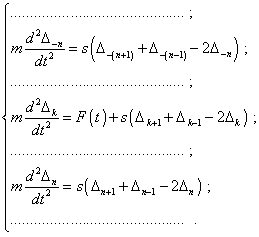Materials.Technologies.Tools |
18 |
S.B. Karavashkin |
|
|
|
Materials.Technologies.Tools |
18 |
S.B. Karavashkin |
|
|
|
Check the correspondence of (8) to (4). Conveniently use for it, basing
on (9), the condition at which
the regime |
 |
(21) |
For the nth equation |
 |
(22) |
It is obvious from (21) and (22) that (8) also satisfies the system (4), the same as (6) and (7). As the above calculations show, (6), (7) and (8),
corresponding to all three mentioned regimes of vibration processes, completely satisfy
all equations of the modelling system, by contrast to above conventional solution (2).
With it, the given solutions are complete, because they cover the whole interval 0 One more distinction from the known solutions is that minimal changes in the model bring considerable changes in solutions; this can be easily proved by the example of infinite line. 2.2. Infinite line The mechanical model of an infinite line is given in Fig. 5.
|
Fig. 5. Mechanical model of infinite elastic lumped line
|
The system of differential equations describing this model has the form |
 |
(23) |
The distinction of (23) from (4) is, the elements with negative
numbers n appear in the line and, in this connection, the equation describing the
line boundary (the first equation of system (4)) disappears from (23). As a result,
instead three, the given system has two solutions related to the periodical regime
at |
| (24) |
and aperiodical one at |
| (25) |
The finite solution for critical regime is absent, and solutions themselves differ both in their amplitude and phase parts. The typical form of vibration for the periodic regime is given in Fig. 6. |
Fig. 6. The typical appearance of vibrations for the
periodical regime ( = 15 Hz, F0 = 0,6 N, m = 0,01 kg, s =
100 N/m, a = 0,01 m, fcrit = 31,8 Hz,
|